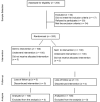Pethidine in Low Doses versus Dipyrone for Pain Relief in Labor: A Randomized Controlled Trial
- PMID: 30786304
- PMCID: PMC10418355
- DOI: 10.1055/s-0038-1676509
Pethidine in Low Doses versus Dipyrone for Pain Relief in Labor: A Randomized Controlled Trial
Abstract
Objective: To compare low doses of pethidine with dipyrone in labor analgesia.
Methods: In a randomized prospective study conducted by Universidade de Fortaleza, in the state of Ceará, Brazil, between May and December 2016, 200 full-term parturients, with very painful uterine contractions and exhibiting uterine cervix dilatation ≥ 5 cm, were selected to receive a single intravenous dose of either 0.25 mg/kg of pethidine (n = 100) or of 25 mg/kg of dipyrone (n = 100). Pain was assessed using the visual analogue scale. The data were analyzed using the Student t-test, the chi-square test and the likelihood ratio.
Results: There was a significant improvement in pain in 35% of the parturients. Both drugs presented a similar analgesic effect 1 hour after the intervention (p = 0.692). There was no analgesic effect during the evaluation of the second hour after the intervention with pethidine or dipyrone. There were no adverse effects, such as maternal drowsiness, nausea or vomiting, related to the drugs used.
Conclusion: Pethidine in low doses and dipyrone presented equivalent analgesia during labor.
Public registry of clinical trials: RBR-4hsyy4.
Objetivo: Comparar doses baixas de petidina com dipirona na analgesia de parto. MéTODOS: Em um estudo prospectivo randomizado realizado pela Universidade de Fortaleza, Ceará, Brasil, entre maio e dezembro de 2016, 200 parturientes a termo, com contrações uterinas muito dolorosas e apresentando dilatação do colo uterino ≥ 5 cm, foram selecionadas para receber dose única intravenosa de 0,25 mg/kg de petidina (n = 100) ou 25 mg/kg de dipirona (n = 100). A dor foi avaliada pela escala visual analógica. Os dados foram analisados por meio dos testes t de Student, qui-quadrado e razão de verossimilhança.
Resultados: Houve melhora significativa da dor em 35% das parturientes. Ambas as drogas apresentaram efeito analgésico semelhante 1 hora após a intervenção (p = 0.692). Inexistiu efeito analgésico durante a avaliação da segunda hora após a intervenção com a petidina ou com a dipirona. Não houve efeitos adversos, como sonolência, náuseas ou vômitos maternos, relacionados aos medicamentos utilizados. CONCLUSãO: A petidina em doses baixas e a dipirona apresentaram analgesia equivalente durante o trabalho de parto. REGISTRO PúBLICO DE TESTES CLíNICOS: RBR-4hsyy4.
Thieme Revinter Publicações Ltda Rio de Janeiro, Brazil.
Conflict of interest statement
The authors have none to declare.
Figures
Similar articles
-
The RESPITE trial: remifentanil intravenously administered patient-controlled analgesia (PCA) versus pethidine intramuscular injection for pain relief in labour: study protocol for a randomised controlled trial.Trials. 2016 Dec 12;17(1):591. doi: 10.1186/s13063-016-1708-3. Trials. 2016. PMID: 27955688 Free PMC article. Clinical Trial.
-
Intravenous infusion of paracetamol versus intravenous pethidine as an intrapartum analgesic in the first stage of labor.Int J Gynaecol Obstet. 2012 Jul;118(1):7-10. doi: 10.1016/j.ijgo.2012.01.025. Epub 2012 Apr 12. Int J Gynaecol Obstet. 2012. PMID: 22503494 Clinical Trial.
-
A comparison of tramadol and pethidine analgesia on the duration of labour: a randomised clinical trial.Aust N Z J Obstet Gynaecol. 2009 Feb;49(1):59-63. doi: 10.1111/j.1479-828X.2009.00949.x. Aust N Z J Obstet Gynaecol. 2009. PMID: 19281581 Clinical Trial.
-
Analgesic Efficacy and Adverse Effects of Meperidine in Managing Postoperative or Labor Pain: A Narrative Review of Randomized Controlled Trials.Pain Physician. 2020 Mar;23(2):175-201. Pain Physician. 2020. PMID: 32214301 Review.
-
Does pethidine relieve pain?Pract Midwife. 2005 Jul-Aug;8(7):16, 18-20, 22-5. Pract Midwife. 2005. PMID: 16044989 Review. No abstract available.
Cited by
-
Comparative efficacy of opioid and non-opioid analgesics in labor pain management: A network meta-analysis.PLoS One. 2024 Jun 18;19(6):e0303174. doi: 10.1371/journal.pone.0303174. eCollection 2024. PLoS One. 2024. PMID: 38889108 Free PMC article.
-
Assessment of Medicalization of Pregnancy and Childbirth in Low-risk Pregnancies: A Cross-sectional Study.Int J Community Based Nurs Midwifery. 2022 Jan;10(1):64-73. doi: 10.30476/IJCBNM.2021.90292.1686. Int J Community Based Nurs Midwifery. 2022. PMID: 35005042 Free PMC article.
References
-
- Jasiecka A, Maślanka T, Jaroszewski J J.Pharmacological characteristics of metamizole Pol J Vet Sci 20141701207–214.. Doi: 10.2478/pjvs-2014-0030 - PubMed
-
- Stramrood C AI, Doornbos B, Wessel I, et al. Fathers with PTSD and depression in pregnancies complicated by preterm preeclampsia or PPROM Arch Gynecol Obstet 201328704653–661.. Doi: 10.1007/s00404-012-2611-0 - PubMed
-
- Reena K HB, Afzal M, Mishra A K, Paul A.Labor epidural analgesia: past, present and future Indian J Pain 20142871–81.. Doi: 10.4103/0970-5333.132843
Publication types
MeSH terms
Substances
LinkOut - more resources
Full Text Sources
Research Materials

